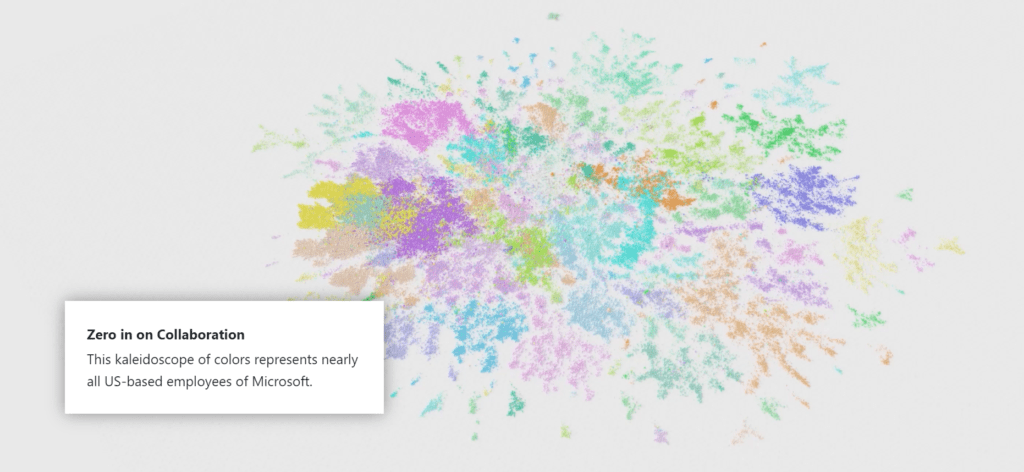|
|
Jonathan Larson and Darren Edge from Microsoft Research have recently published the findings of a data-powered visualization study of how teams really work together. The premise of the study was that organizational structure charts rarely reflect the way that individuals within companies and teams actually work together.
Using their own organization as a microcosm, the pair used aggregated data from emails, communications using Microsoft Teams, calls, and meetings to determine how closely different members of the Microsoft team work together regardless of reporting lines, departments, and geographic location.
They hypothesize that Microsoft is representative of similar organizations with teams with a wide variety of expertise spread across different departments and which are geographically disparate. They also suggest that similar data-driven studies could work as a useful diagnostic tool for organizations.
The study resulted in a number of insights that might seem intuitive to digital nomads, but which management teams have been struggling to reconcile following the move to remote and hybrid working over recent years.
Let’s look at some of the report’s findings and insights.

Teams form and disband
The study shows that teams working together are rarely defined by job titles, departments, or physical proximity. Multidisciplinary teams that cross apparent boundaries within the organization form quickly around specific projects and are disbanded when the work is done.
This reflects a steady move towards project-based approaches to working that take advantage of labs and sprints to move company interests forward in high-intensity bursts outside the day-to-day delivery of company services.
This is a high-level image of what collaboration looks like at Microsoft. Every dot represents an individual and they are placed in relation to one another based on how closely they communicate. Larger dots have more frequent communication and the most well-connected individuals within the network are near the center of the visualization. The colors represent distinct cohorts that work together.

There are benefits to flexibility and autonomy
The research suggests that when teams form, they tend to change with every project, rather than the same group of individuals coming together to face individual challenges. This is especially true when the team is geographically distributed.
This suggests that the flexibility and autonomy that come with remote working may make interdisciplinary teams more dynamic as there are fewer perceived limitations on who can work together. While teams that are physically based together tend to work together, remote teams can pull on the best talent, regardless of where it is located.
Hybrid working has not diminished communication
While managers may feel like hybrid teams that involve remote workers communicate less, due to reduced traditional visibility of that communication, there is no reason to believe that remote teams have less meaningful communication than their geographically connected counterparts. This reinforces the insight that effective communication does not depend on physical presence.
Research shows that 85% of leaders are highly concerned about the switch to hybrid working and its impact on community and productivity. This study suggests that the problem is not remote working per se but applying attitudes about physical teams to geographically diverse teams.

Networks sprawl
The study found that there are some small teams that work in a tight-knit, and isolated manner, most individuals within a company have a sprawling network that crosses departmental and geographic lines. Communication between individuals is usually decentralized and does not rely on management for mediation.
One concern about the move to remote working has been the loss of “serendipity” as people from different departments come together in informal work settings and innovate. The study suggests that remote employees are still reaching out to one another to make those connections.
Communication insights can help identify dysfunction
These kinds of communication visualizations are not only useful for better understanding how teams work together but also for diagnosing dysfunction within the network. When there is a lack of meaningful communication between related teams or line management and their teams, this can be identified.
A lack of communication can suggest an issue within the company hierarchy with the wrong people working together. The researchers were also able to track the effects of reorganizations by comparing communication patterns before and after the changes.

![]()
Data-driven decision-making can be powerful
Overall, the researchers on the project are advocating for data-driven decision-making. They point out that the visualizations developed from the data reveal facts about work approaches that are not necessarily evident when you are part of the network.
The software used by most companies has the power to produce similar insights and this can be a valuable tool for assessing work patterns, evaluating collaborations, and in turn making informed decisions about teams, projects, and company structures.
Companies need to adapt
Probably the overall major conclusion of the research is that companies need to adapt to the new hybrid working environment and see it as an opportunity rather than a handicap. Trying to force modern, disparate teams into modes of working designed for teams that are physically located together is not only counterproductive but diminishes the clear benefits of hybrid and remote teams.










